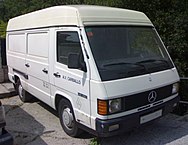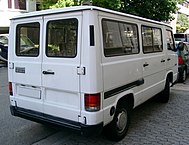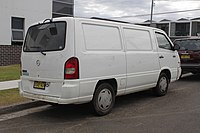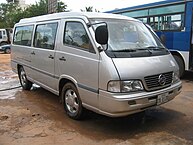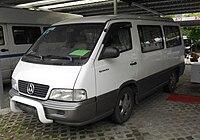auto.wikisort.org - Automobile
The Mercedes-Benz MB100 (Model type 631) is a light commercial cabover van (M) made by Mercedes-Benz España S.A. from 1981 to 1996 at their Vitoria-Gasteiz factory in northern Spain. The third generation model was manufactured by SsangYong alongside the rebadged SsangYong version from 1995 to December 2003 in South Korea, with another rebadged variant manufactured by Maxus of SAIC Motor from 2009 to 2014 in China.
First generation (1981)
| Mercedes-Benz MB90-MB180 | |
|---|---|
 1986 Mercedes-Benz MB90 | |
| Overview | |
| Manufacturer |
|
| Production | 1980–1986 |
| Assembly | Spain: Vitoria-Gasteiz |
| Body and chassis | |
| Class | Light commercial vehicle (M) |
| Body style | Van Minibus Pickup truck |
| Layout | FF layout |
| Powertrain | |
| Engine | |
| Transmission | 4-speed manual |
| Dimensions | |
| Wheelbase | 2,500 mm (98.4 in) |
| Chronology | |
| Predecessor | Mercedes-Benz N 1000/N 1300 |
The first generation model arrived in September 1980, and was initially available in two weight ratings: The MB100 and the heavier duty MB130.[1] Mercedes-Benz España S.A. had obtained the Vitoria factory from Industrias del Motor S.A. (IMOSA) which had been making the DKW F1000 L van there. The F1000 L was a development of the DKW Schnellaster, but with a Mercedes-Benz diesel engine instead of the original DKW two-stroke petrol engine. This was further developed into the Mercedes-Benz N1300, which then became the original MB100-series after yet another facelift. Elements of Fissore's original trapezoidal design for Auto Union were still evident, for instance in the front door window profiles. The new design was offered as a cargo van, a passenger van, and a pickup truck. This model was entirely redesigned during 1986.
The model names (ranging from MB90 to MB180) reflected the payload in tens of kilograms. The MB100 (and the MB90, which arrived in 1985) were powered by the 2.0-litre OM615 diesel four-cylinder making 58 PS (43 kW), an engine built in Barcelona. The heavier MB130, 140, 150, and 180 models received the larger, 2.4-litre OM616 engine with 72 PS (53 kW). The first MB100-series was not exported in any significant numbers.
The MB100-series was initially built by a company called MEVOSA, of which Mercedes-Benz held a 52.77 percent share as of November 1980. Spanish government industrial holding company INI held around forty percent, dropping to just over 25 percent in 1983.[2] With Mercedes having become the majority owner, they renamed the company "Mercedes-Benz España, S.A." in April 1981.[3]
- The MB100 still showed the roots of Fissore's 1963 design
- A variety of bodystyles were available, including this ice cream truck design
Second generation (1987)
| Mercedes-Benz MB100 (W631) | |
|---|---|
 Facelift model (1992-1996) | |
| Overview | |
| Manufacturer | Mercedes-Benz |
| Also called | Mercedes-Benz Cityliner (Finland)[4] |
| Production | 1987 - 1996 |
| Assembly | Spain: Vitoria-Gasteiz (Mercedes-Benz España, S.A.) Philippines: Manila (Mercedes-Benz Philippines) Turkey: İzmir (BMC) |
| Body and chassis | |
| Class | Light commercial vehicle (M) |
| Body style | Van Minibus Pickup truck |
| Layout | FF layout |
| Related |
|
| Powertrain | |
| Engine | 2.4 L OM616 I4 (And also with AMG version);
|
| Transmission | 5-speed manual |
| Dimensions | |
| Wheelbase | 2,455 mm (96.7 in) (MB100) 2,680 mm (105.5 in) (MB140) |
| Length | 4,890 mm (192.5 in) (MB100) 5,340 mm (210.2 in) (MB140) |
| Width | 1,855 mm (73.0 in) |
| Height | 2,000 mm (78.7 in) |
| Kerb weight | 1,710 kg (3,769.9 lb) (MB100) 1,725 kg (3,803.0 lb) (MB100D) |
| Chronology | |
| Successor | Mercedes-Benz Vito |
The new, very square looking MB100 (model type W631) was presented in Mallorca in January 1987.[5] This was also when the Spanish-made vans were finally offered in Northern Europe, including Germany. Spanish market vehicles received different model numbers reflecting the payload in tens of kilograms, including MB100, 120, 140, and 180.
Most MB100 were powered by the 2.4 litre OM616 diesel four-cylinder making about 72 PS (53 kW), an engine also used in the Mercedes Benz 207D. This was later uprated to 75 PS (55 kW).[6] Also it has two versions by AMG — with inline-4 2.4-liter turbocharged OM616 engine (95 hp) and with inline-5 3.0-liter turbocharged OM617 (120-127 hp).[7] Later, a 2.9-liter inline-five diesel was added, as were petrol four-cylinder options after 1996.
The MB100 was offered in Germany from 1987 to 1996 as an extension of Daimler-Benz's commercial motor vehicle range.[8] In 1992 the MB100 was given a slanted radiator and an extended front end, intended among other things to enhance safety in a collision.[8] Heavier-duty versions were called the MB140 and MB180.
The MB100 was replaced by the Mercedes-Benz Vito in 1996, but remained available for export markets such as Brazil and Argentina until 1997 when the Sprinter started to be made in Argentina.[9] In Germany, the MB100 developed a reputation for rust, slowness, and a weak chassis.[8]
BMC of Turkey assemble the MB100 for the local market. Later, they adapted the MB100's bodywork for their cabover series of Levend trucks, vans, and minibuses, although they installed it on a rear-wheel-drive chassis, using the 3-litre BD30 direct injection diesel engine from Nissan.
- Spanish market Mercedes-Benz MB180 of the original design, high roof van model
- The original (1987–1992) design
- Rear view (facelift model)
- The Turkish-made BMC Levend's bodywork was derived from the MB100
Third Generation (1996)
| Mercedes-Benz MB 100 | |
|---|---|
 | |
| Overview | |
| Manufacturer | SsangYong |
| Also called |
|
| Production | 1995–December 2003 (South Korea) 2009–2014 (China) |
| Assembly |
|
| Body and chassis | |
| Class | Minivan |
| Body style | 4-door van 4-door minibus |
| Layout | FF layout |
| Powertrain | |
| Engine | 2.3 L M111 petrol I4; 2.9 L OM602 diesel I5 |
| Chronology | |
| Successor | Mercedes-Benz Vito SsangYong Rodius/Stavic Maxus G10 |
In 1999, DaimlerChrysler Australia/Pacific introduced the MB100 and the MB140 (Model type 661), a larger derivative of the MB100, to the Australian and Pacific markets.[10] These vans were manufactured under licence by the SsangYong Motor Company, which also made a rebadged version called the SsangYong Istana.[citation needed] The Pacific market MB100D and MB140D both used a licensed version of the naturally aspirated 2.9L OM602 I5 motor from Mercedes mated to a 5 speed manual transmission while the MB100 and MB140 used a licensed Mercedes M111 2.3L petrol engine mated to a 5 speed as well. There were both van and minibus versions with the bus versions having sliding windows, rear concealed air conditioning in the ceiling and convenience lights for the comfort of passengers. In some markets, for example Singapore, there was also an electric step which would slide out when the sliding door was opened for the convenience of passengers. They were made in both right and left hand drive depending on the market it was in and depending on seat arrangement, could accommodate up to 15 people. In late 2004, Shanghai Huizhong Automotive Manufacturing Co., Ltd. took over a major stake in Ssangyong's automobiles division and started manufacturing a redesigned version of the Pacific market MB140.
Rebadged variants
The SsangYong Istana was a 2, 9, 12 and 15 seater minivan and minibus. It was a licensed rebadged version of the Mercedes-Benz MB100 'Bus' variant. It comes with most of the options of the MB100 as well.[11] The name "Istana" is Malay and Indonesian for "palace", which is the name of the presidential residences in both Singapore and Indonesia.
- SsangYong Istana manufacturer's plate
- A SsangYong Istana in Cambodia 2008
- A Mercedes-Benz MB 140 D in Bangkok
- Daewoo Istana in Chile
- A SAIC Maxus Istana
- Sanxing SXZ6492 in China
References
Notes
- "September 1980: New van models from Spain". M@RS – The Digital Archives of Mercedes-Benz Classic. Mercedes-Benz AG. Archived from the original on 14 May 2021.
- Mendizabal, González de Langarica. "Mercedes-Benz España - Factoría de Vitoria" [Vitoria Plant]. Auñamendi Eusko Entziklopedia (in Spanish). Eusko Ikaskuntza. Archived from the original on 7 December 2017.
- "4 November 1980: Daimler-Benz realigns Spanish operations". M@RS – The Digital Archives of Mercedes-Benz Classic. Mercedes-Benz AG. Archived from the original on 14 May 2021.
- "Mercedes-Benz Cityliner". Helsingin Sanomat (in Finnish). Helsinki. 10 December 1989. p. A12. Retrieved 10 August 2021.
- "1955 to 1994 Vans for every purpose: Mercedes-Benz MB100". Mercedes-Benz Ireland Vans. Daimler AG. Archived from the original on 11 August 2013.
- "Mercedes-Benz Vans: Our Achievements – Mercedes-Benz-Vans.ca". Mercedes-Benz Vans. Retrieved 25 December 2021.
- Petrány, Máté (16 February 2018). "This Diesel Van Is the Strangest Vehicle in AMG's History". Road & Track. Retrieved 25 December 2021.
- Lingner, Heinrich (9 May 2021). "Ein Transporter nicht nur für Hähnchen-Griller" [A Transporter not only for chicken grillers]. Auto Motor und Sport, Youngtimer (in German). Motor Presse Stuttgart GmbH & Co.KG. Archived from the original on 12 May 2021.
- "Mercedes-Benz Classic - Vans - 1994-2005 - 1996: The Mercedes-Benz Vito". Retrieved 14 October 2010.
- "AutoWeb: Mercedes Unveils A New Vision In Vans". Australia: Web Publications Pty. 26 November 1999. Archived from the original on 19 November 2011. Retrieved 14 October 2010.
- Vaston-Avto Archived 2012-07-15 at archive.today (in Russian)
Bibliography
- Röcke, Matthias (2008). Mercedes-Benz Transporter: Postwar to Present Day. Königswinter, Germany: Heel Verlag. ISBN 9783868520682.
- "Mercedes-Benz MB100 Panel Van Specifications" (PDF). Mulgrave, Victoria, Australia: DaimlerChrysler Australia/Pacific Pty. Archived from the original (PDF) on 6 July 2011. Retrieved 14 October 2010.
External links
На других языках
[de] Mercedes-Benz MB 100
Der Transporter der Serie MB 100–180 ist ein leichtes Nutzfahrzeug der Marke Mercedes-Benz aus dem Transporterbereich von Daimler-Benz. Er wurde in Spanien in verschiedenen Ausführungen, so zum Beispiel als Kastenwagen, Kombi I (teilverglast), Kombi II (teilverglast), Kleinbus (rundum verglast), Pritschenwagen und als Fahrgestell (z. B. als Basis für Verkaufswagen oder Wohnmobile) hergestellt. Die Typenbezeichnung MB 100–180 bezeichnete die ungefähre Nutzlast der einzelnen Modelle, nämlich ca. 1000–1800 kg.[1]- [en] Mercedes-Benz MB100
[es] Mercedes-Benz MB 100
La Mercedes-Benz MB 100 es una furgoneta mediana introducida en 1981, manufacturada por el fabricante alemán Mercedes-Benz en la fábrica que tiene en Vitoria, en el País Vasco en el norte de España. Su predecesora fue la Mercedes-Benz N1300.[fr] Mercedes-Benz MB100
Le Mercedes-Benz MB100 est un petit utilitaire créé par DKW et vendu dans toute l'Europe de 1987 à 1995. Ce véhicule a connu divers développements jusqu'en 1992, date à laquelle le Vito a pris la relève. La première version de ce véhicule était équipée d'un moteur deux-temps, spécialité de DKW.[it] Mercedes-Benz MB 100
L'MB100 è un veicolo commerciale leggero commercializzato da Mercedes-Benz dal 1981, in sostituzione del DKW F1000L, al 1995, sostituito dal Mercedes Vito.[ru] Mercedes-Benz MB100
Mercedes-Benz MB100 — семейство малотоннажных автомобилей компании Mercedes-Benz. Серийное производство автомобилей длилось с 1981 по 1996 год. Автомобиль производился как фургон и микроавтобус, приводился в действие 2,4-литровым дизельным двигателем мощностью около 55 кВт, который также использовался в Mercedes-Benz TN 207D, а также предлагался в Германии с 1987 по 1995 год для расширения производства коммерческих автомобилей Daimler-Benz. В 1992 году автомобиль получил наклонный радиатор и удлинённую переднюю часть, предназначенную для повышения безопасности при столкновении. Семейство MB100 было вытеснено семейством W638 в 1996 году, но оставалось доступным для экспортных рынков Бразилии и Аргентины до 1997 года, когда в Аргентине стартовало производство семейства Sprinter.Другой контент может иметь иную лицензию. Перед использованием материалов сайта WikiSort.org внимательно изучите правила лицензирования конкретных элементов наполнения сайта.
WikiSort.org - проект по пересортировке и дополнению контента Википедии


